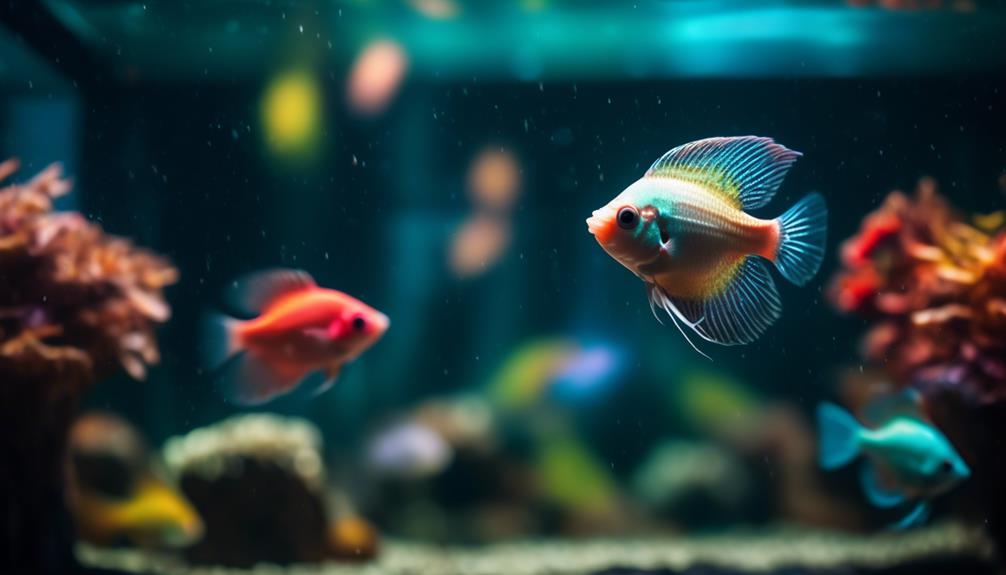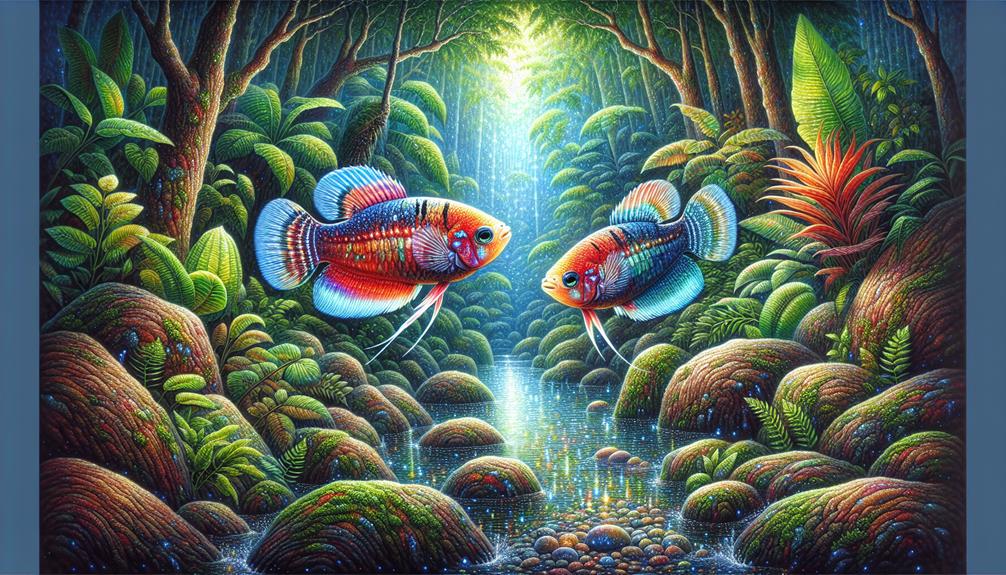The underwater world is teeming with fascinating creatures, each with its own unique charm. Among them, the dwarf gouramis stand out with their vibrant colors and captivating personalities. These small, yet stunning, fish have captured the attention of aquarium enthusiasts worldwide.
But what makes them so special?
In this article, we will explore the captivating world of dwarf gouramis, unveiling their striking characteristics, the secrets to creating a perfect habitat, and the art of nurturing their health and breeding success.
So, prepare to be captivated by the mesmerizing world of these colorful aquatic gems.
Key Takeaways
- Dwarf gouramis are small, colorful fish native to South Asian countries like India, Pakistan, and Bangladesh.
- They require a 10-gallon or larger aquarium with slow flow and live plants.
- Dwarf gouramis are adaptable to a wide range of pH levels and temperatures.
- When breeding dwarf gouramis, it is important to condition the adults, set up a breeding tank, and remove the female after mating to prevent aggression from the male.
Characteristics of Dwarf Gouramis
Dwarf Gouramis, belonging to the Trichogaster lalius species, are small freshwater fish known for their vibrant colors, territorial behavior, and unique lung-like labyrinth organ.
These fish are native to South Asian countries like India, Pakistan, and Bangladesh. Dwarf Gouramis have a shiny, light blue body with red, vertical stripes, making them a visually appealing addition to any aquarium.
When setting up an aquarium for Dwarf Gouramis, it is important to provide a 10-gallon or larger tank with slow flow and live plants. These fish can tolerate pH levels of 6-8 and temperatures from 72-82°F (22-28°C), and they are adaptable to both soft and hard water conditions. However, it is crucial to avoid keeping multiple male Dwarf Gouramis together due to their territorial behavior. Compatible tank mates for Dwarf Gouramis include corydoras catfish, tetras, rasboras, loaches, and platies.
These fish are omnivorous and have a varied diet, including fish flakes, betta pellets, bloodworms, and brine shrimp. They may also feed on algae.
Breeding Dwarf Gouramis requires locating a female, as they are not commonly available in stores. The adults should be conditioned with high-quality foods before breeding, and a 10-gallon breeding tank with shallow water and floating plants should be set up. The male builds a bubble nest, and the female releases eggs for him to collect. To prevent aggression, the female should be removed after mating.
Setting Up the Perfect Aquarium
To create an optimal environment for Dwarf Gouramis, careful attention must be given to the setup of the aquarium. The importance of water quality in a dwarf gourami tank cannot be stressed enough. These fish are sensitive to poor water conditions, so it is vital to maintain a clean and well-filtered tank. Regular water changes and monitoring of pH levels, temperature, and ammonia levels are essential.
Tips for creating a natural and stimulating environment for dwarf gouramis include providing live plants, driftwood, and rocks for them to explore and hide among. The addition of floating plants also helps to mimic their natural habitat and provides shade and cover. Creating slow water flow using a gentle filter or air stone is recommended, as Dwarf Gouramis prefer calm waters.
Furthermore, ensuring a balanced diet and suitable tank mates is crucial for the well-being of these fish. Offering a varied diet consisting of fish flakes, betta pellets, bloodworms, and brine shrimp will promote their health and vibrant coloration. When choosing tank mates, consider peaceful species like corydoras catfish, tetras, rasboras, loaches, and platies, while avoiding multiple male Dwarf Gouramis due to their territorial behavior.
The Ideal Diet for Dwarf Gouramis

A well-balanced and nutritious diet is essential for maintaining the health and vibrant coloration of Dwarf Gouramis. To provide optimal nutrition for these beautiful fish, it is important to follow a feeding schedule and practice portion control. Here are some key points to consider:
- Variety: Offer a varied diet that includes high-quality fish flakes, betta pellets, bloodworms, and brine shrimp. This ensures that the gouramis receive a wide range of nutrients for their overall well-being.
- Sinking and Floating Foods: Dwarf Gouramis are omnivorous and can eat both sinking and floating foods. Provide a mix of these food types to accommodate their feeding preferences.
- Algae Consumption: Dwarf Gouramis may also feed on algae, so it is beneficial to have some algae growth in the aquarium. However, be sure to monitor the algae growth to prevent overfeeding.
Breeding Tips for Dwarf Gouramis
When it comes to breeding Dwarf Gouramis, there are several important factors to consider in order to ensure a successful and stress-free process.
One of the main breeding challenges is the availability of females, as they are not commonly found in stores. Therefore, it is crucial to locate a female before attempting to breed these fish.
Prior to breeding, it is recommended to condition the adults with high-quality foods to ensure their overall health and readiness to reproduce.
Setting up a 10-gallon breeding tank with shallow water and floating plants is essential for creating a suitable environment for the spawning process.
The male will build a bubble nest, and the female will release the eggs for him to collect. To prevent aggression from the male, it is important to remove the female after mating.
Exploring Other Peaceful Gourami Species

After successfully breeding Dwarf Gouramis, aquarists may want to explore other peaceful gourami species to add to their community tanks. Here are some options to consider:
- Honey Gourami (Trichogaster chuna):
- Peaceful nature, making it an excellent community tank member.
- Distinctive golden coloration with black markings.
- Smaller size, reaching up to 2 inches (5 cm) in length.
- Compatible tank mates include small tetras, rasboras, and dwarf corydoras catfish.
- Pearl Gourami (Trichopodus leerii):
- Known for its stunning iridescent scales.
- Peaceful demeanor and can be kept with a wide range of tank mates.
- Grows up to 4 inches (10 cm) long.
- Prefers densely planted tanks with plenty of hiding spots.
- Moonlight Gourami (Trichogaster microlepis):
- Features a beautiful silvery-blue body with dark markings.
- Peaceful and can coexist with other peaceful fish species.
- Grows up to 4 inches (10 cm) long.
- Enjoys a well-maintained tank with floating plants and hiding spots.
When considering tank mates for dwarf gouramis, it is important to choose peaceful species that share similar water parameters. Additionally, it is crucial to understand the differences between male and female dwarf gouramis. Males display vibrant colors and long, flowing fins, while females have shorter fins and less intense coloration. By carefully selecting suitable tank mates and understanding the characteristics of male and female dwarf gouramis, aquarists can create harmonious and visually appealing community tanks.
Frequently Asked Questions
How Long Do Dwarf Gouramis Live?
The lifespan of dwarf gouramis can vary, but on average, they live for 3-5 years. Factors that affect their lifespan include water quality, diet, genetics, and overall care provided by the owner.
Can Dwarf Gouramis Be Kept With Aggressive Fish Species?
Dwarf gouramis should not be kept with aggressive fish species due to their peaceful nature. They are best suited for community tanks with compatible tank mates like corydoras catfish, tetras, rasboras, loaches, and platies.
What Are Some Common Diseases That Affect Dwarf Gouramis?
Preventive measures for common diseases that affect dwarf gouramis include maintaining clean water conditions, proper diet, and avoiding overcrowding. Treatment options vary depending on the specific disease, but may involve medication, quarantine, and adjustments to water parameters.
Can Dwarf Gouramis Be Kept in a Community Tank With Other Species of Gouramis?
Keeping dwarf gouramis with other species of gouramis in a community tank has both pros and cons. Pros include variety and visual appeal, while cons include possible aggression and territorial behavior. Best tank mates for dwarf gouramis include corydoras catfish, tetras, rasboras, loaches, and platies.
Do Dwarf Gouramis Require Any Special Care or Maintenance?
Dwarf gouramis require special care and maintenance. They need a varied diet including fish flakes, betta pellets, bloodworms, and brine shrimp. They also require a minimum tank size of 10 gallons for their well-being.
Conclusion
In conclusion, the world of dwarf gouramis offers a captivating and colorful experience for aquarium enthusiasts. From their unique appearance to their care requirements and breeding habits, these vibrant aquatic creatures are truly one-of-a-kind.
By following the guidelines for setting up the perfect aquarium, providing a balanced diet, and exploring other peaceful gourami species, enthusiasts can create a harmonious and captivating aquatic habitat.
Dive into the world of dwarf gouramis and unlock the beauty and fascination that these creatures have to offer.

